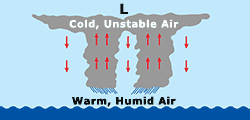What Makes Hurricanes?

Hurricanes are making headlines these days. Cities are devastated; whole islands are without electricity, fuel or water. Hundred-year storms seem to occur every year. Some blame global warming, others say twentieth century storms were mild by historical standards. But what causes hurricanes? And why do they usually start at certain times of year and in the same places?2
Hurricanes Are the Product of Science and Chance. The ancients believed gods controlled the winds. Today we know that hurricanes are the product of science and chance. Science provides the necessary ingredients; chance the likelihood the right combination comes together at the same time. Hurricanes couldn’t happen without the scientific components, but without chance they either would occur all the time or not at all.
The Basic Science. Hurricanes start with moist air passing over warm water. As the air is heated it rises and cooler air pours in to take its place. That air in turn is warmed and rises, pulling in more cool air and the cycle continues.
The warm air cools as it rises, forming clouds. The rotation of the Earth makes the whole thing swirl. This is called the Coriolis effect (see sidebar) and in the Northern hemisphere it makes hurricanes spin counterclockwise.
The Role of Chance. The basics are simple, but many other factors need to come together for a hurricane to develop. Typically the water temperature needs to be at least 79° to a depth of 50 meters. And the air must be humid and cool rapidly as it rises to allow condensation. Finally there needs to be some existing weather disturbance.
Other factors impede storm creation. Strong wind shears, for example, disrupt the spiraling winds (think how an object sitting in a sink disrupts water spiraling down the drain).
The likelihood of all these elements coming together in the right combination is the chance element of weather. Without it weather forecasts would be as certain as phases of the Moon.
Why Do Hurricanes Tend to Occur in Certain Times and Places? Given the right conditions a hurricane can form at any time and in any place. But since they need warm water they tend to occur in the summer and early autumn. In fact hurricane season doesn’t really get underway until several weeks into summer since it takes a while for warm weather to heat the water.6
Hurricanes tend to occur in certain regions because those areas have conditions favorable to their creation. The Coriolis effect is very weak near the equator, so hurricanes typically start at least 5° north or south. In the northern hemisphere hurricanes tend to move toward the west-northwest, so those that form in the Atlantic move toward the East coast of the U.S. On the west coast of the U.S. this northwest motion would push hurricanes away from land.

Another reason the Pacific coast doesn’t have many hurricanes is ocean currents keep the water cool. One needs to go as far south as Central Mexico for Pacific water to be warm enough.7
What About Global Warming? We really won’t know how global warming affects hurricanes until our descendants read about it in their history books. Studies have come to differing conclusions. Global warming does not change hurricane science, but it might increase the likelihood that conditions necessary for their creation come together, or that those that do occur are more severe.8
Why So Many 100-Year Storms? People sometimes wonder why recent years have seen so many “100-year” storms. The terminology is confusing — 100-year storm doesn’t mean a storm won’t happen again for another 100 years, it’s just a way of saying there is a one percent of a storm of that intensity occurring. Just like a lucky person can win the lottery twice in a row, an unlucky place can suffer several severe hurricanes within a short time.
* * * * *
People sometimes think they run the world — hurricanes are nature’s way of showing who’s really in charge. NOAA calculates that the total energy released by an average hurricane is 200 times the world’s total electrical generating capacity.9 Humbling and sure makes our supposed technological marvels seem puny.
-----
- Based on NASA diagram.
- General information for this article comes from How Do Hurricanes Form? on NASA’s web site; How Does a Hurricane Form? also on NASA’s web site and Wikipedia article on tropical cyclones.
- For more information see, What Is the Coriolis Effect? on SciJinks web site and Coriolis Effect on the National Geographic Society’s web site.
- Based on illustration on NOAA/NASA Scijinks web site.
- Photo of Hurricane Isabel taken by Astronaut Ed Lu from the International Space Station on September 15, 2003. NASA Photo ID ISS007-E-14887, on-line at NASA web site.
- See Chris Landsea, Why Do Tropical Cyclones Occur Primarily in the Summer and Autumn? NOAA web site.
- See Chris Landsea, Why do hurricanes hit the East Coast of the U.S. but never the West Coast? on-line at Scientific American.
- See Global Warming and Hurricanes, An Overview of Current Research Results on NOAA’s web site.
- Calculation by NOAA’s Atlantic Oceanographic & Meteorological Laboratory. Explanation on-line at lab’s web site.
This article originally appeared in our free semi-monthly newsletter. To receive future issues, please add your name to the subscription list.

